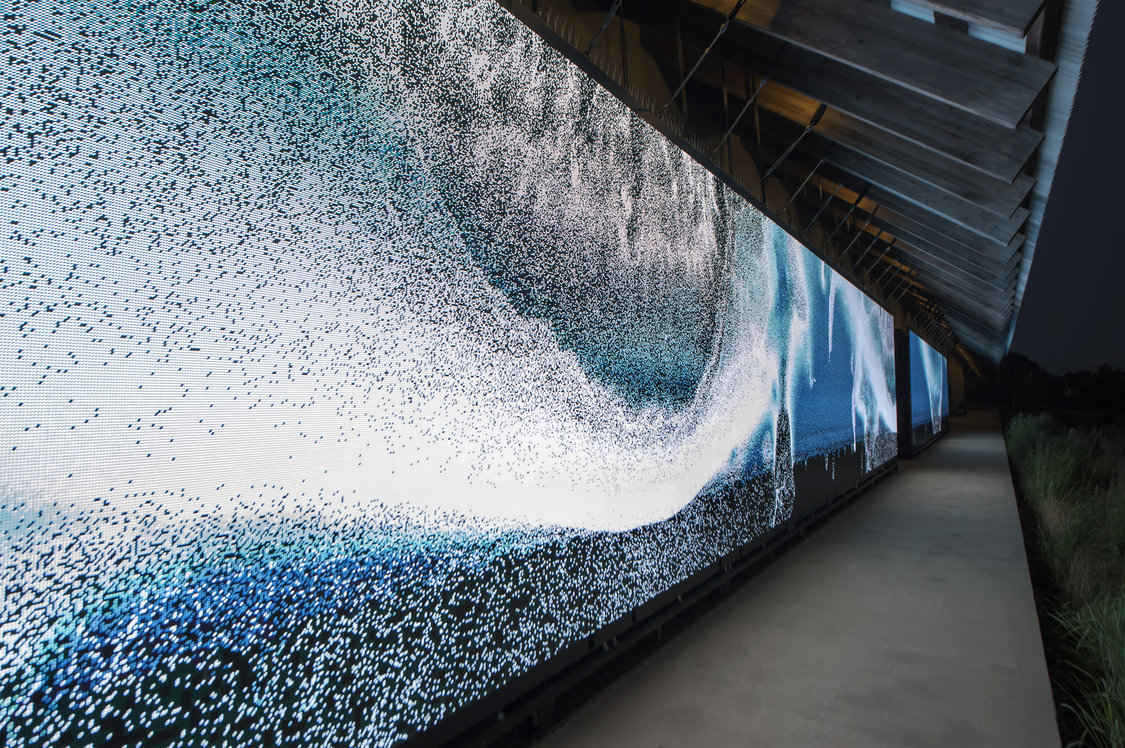- WorldStage has once again collaborated with multi-media artist Clifford Ross, this time providing LED support for his mixed media installation, “Light | Waves,” at the Parrish Art Museum in Water Mill, New York.
Light | Waves at the Parrish Art Museum
“Platform: Clifford Ross Light | Waves” is a solo exhibition of Ross’s monumental Hurricane Wave photographs printed on sheets of maple veneer and computer generated “Digital Wave” videos displayed on massive LED screens outside and inside the Parrish Art Museum, which is located on the east end of Long Island. Platform is an annual exhibition that invites artists to consider the entire Museum as a site for works that encourage new ways to experience art, architecture and the landscape. Platform: Clifford Ross Light | Waves is on view through October 15, 2017.
Ross began his well-known Hurricane Wave series in 1996, entering the surf during extreme weather, often up to his neck, while tethered to an assistant on land. He has expanded his photographic techniques over time, to include digital methods and now a unique method of printing on wood.
“Clifford Ross’s fascination with the ocean off the shore of Long Island gains new meaning with his immersive installation at the Parrish that places the viewer into the midst of crashing hurricane waves in a building situated between two bodies of water,” said Terrie Sultan, Parrish Art Museum Director. “Using new media of his own invention, Ross creates a tension between representation and imagination, realism and abstraction, and ultimately reveals a different ‘truth’ about the ocean.”
Visitors to the Museum, and those driving down Montauk Highway, see Ross’s dynamic “Digital Waves” continually crashing on two 50-foot wide LED screens on the Parrish’s south exterior. In the lobby, an 18x18-foot LED screen further immerses visitors in the virtual ocean.
WorldStage was tasked with providing a complete package, which was comprised of the LED screens, custom rigging solutions for the interior and exterior screens, and a Dataton WATCHOUT media server system. In addition, a control system with a customized user-interface was used to allow the Museum to manually affect the installation, which otherwise runs in automatic mode.
“We worked very closely with Clifford’s team and Parrish personnel to put the necessary programming structures in place to overcome some of the normal impediments that we face on these types of jobs", said Carson Polan-Volpe, Project Associate, Emerging Technologies, at WorldStage. "The Museum is south-facing so a big concern was visibility of the screens depending on the position of the sun. The desire was to have the installation run from 8am to 11pm. In addition to auto startup and shutdown, we successfully implemented brightness control of the LED screens based on the sun’s azimuth."
“Another area of concern was the likely occurrence of inclement weather,” continues Polan-Volpe. “The East End of Long Island is prone to blustery weather, which could potentially adversely affect the outdoor LED screens.” WorldStage had already opted to go with Unilumin U6 IP65 rated tiles, but it was now incumbent upon the team to deal with anchoring the two 50’ wide x 10’ tall screens in place. The Museum was steadfast in their desire to avoid marring any part of the building or walkways, which meant the need for a virtually freestanding structure. As a solution, WorldStage designed and fabricated a custom engineer-certified rigging structure consisting of copious amounts of ballast while still maintaining the desired industrial-art look that Ross was after.
WorldStage selected Unilumin U3 tiles for the lobby’s 18-foot square LED wall, which is ground supported. All three LED walls are run from WATCHOUT and WorldStage technicians are able to log in remotely and monitor the operations of the systems.











